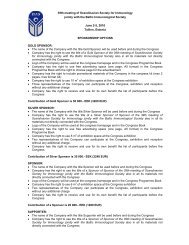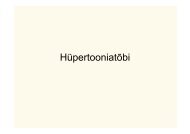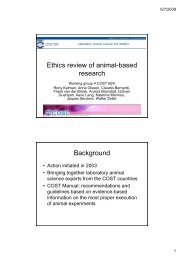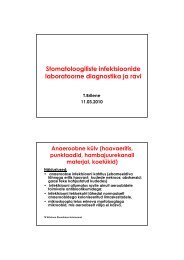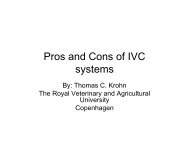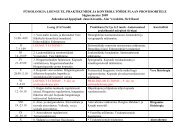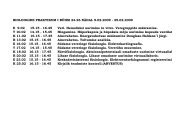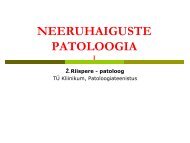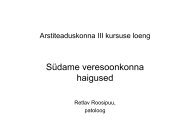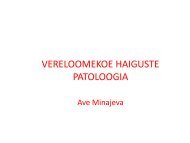ANATOMY 1 Name of the Department: Department ... - Biomeedikum
ANATOMY 1 Name of the Department: Department ... - Biomeedikum
ANATOMY 1 Name of the Department: Department ... - Biomeedikum
You also want an ePaper? Increase the reach of your titles
YUMPU automatically turns print PDFs into web optimized ePapers that Google loves.
PATHOLOGICAL <strong>ANATOMY</strong> AND FORENSIC MEDICINE<br />
<strong>Name</strong> <strong>of</strong> <strong>Department</strong>: <strong>Department</strong> <strong>of</strong> Pathological Anatomy and<br />
Forensic Medicine<br />
Head <strong>of</strong> <strong>the</strong> <strong>Department</strong>: Pr<strong>of</strong>essor Raik-Hiio Mikelsaar<br />
<strong>Name</strong> e<strong>of</strong> <strong>the</strong> Chair: Pathological Anatomy:<br />
Head <strong>of</strong> <strong>the</strong> chair: Pr<strong>of</strong>essor Raik-Hiio Mikelsaar<br />
Subject codes: ARPA.01.014; ARPA.01.008<br />
I. CONTENT OF THE TEACHING<br />
1. Describe shortly <strong>the</strong> main study and student evaluation methods applied at<br />
<strong>the</strong> department.<br />
The main study includes teaching <strong>of</strong> pathology – <strong>the</strong> etiopathogenesis and<br />
characteristics <strong>of</strong> <strong>of</strong> diseases. Lecture-seminars and practical trainings are<br />
carried out. Students are evaluated by current tests and a final examination.<br />
2. How have <strong>the</strong> aims and objectives described in <strong>the</strong> curriculum changed<br />
during <strong>the</strong> past five years?<br />
According to <strong>the</strong> general trends in <strong>the</strong> development <strong>of</strong> pathology, in our course<br />
now <strong>the</strong> morphological descriptions <strong>of</strong> diseases are widely accompanied by<br />
explanation <strong>of</strong> etiopathogenetic mechanisms. Both general and systematic<br />
pathology are studied on lecture-seminars and practical trainings. A logical<br />
sequence <strong>of</strong> general course is applied: initially alterative changes, <strong>the</strong>n inflammatory<br />
processes and finally disorders <strong>of</strong> proliferative-differentiation processes<br />
including tumours are presented. Compared to <strong>the</strong> earlier curriculum,<br />
more emphasis is now paid to <strong>the</strong> molecular pathology and coordination <strong>of</strong><br />
teaching with o<strong>the</strong>r <strong>the</strong>oretical institutes and clinics.<br />
3. Describe <strong>the</strong> strengths and weaknesses <strong>of</strong> <strong>the</strong> teaching in your department.<br />
Strengths<br />
1. The pathology is accepted by students as a basic field <strong>of</strong> medicine and<br />
most <strong>of</strong> <strong>the</strong>m are continuously participating in lecture-seminars and practical<br />
trainings.<br />
2. The information (a text and illustrations) presented on lecture-seminars is<br />
available in a typed form (1200 pages).<br />
3. There is a large collection <strong>of</strong> macro- and micropreparations provided by<br />
description – brochures used for practical trainings.<br />
Weaknesses<br />
Some members <strong>of</strong> staff do not still have a Ph.D degree.<br />
113



